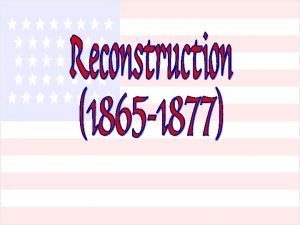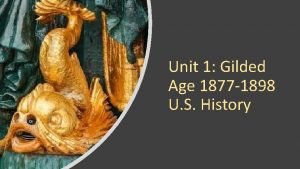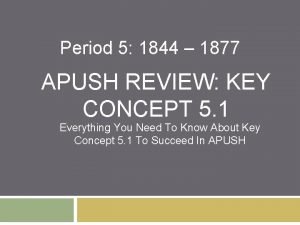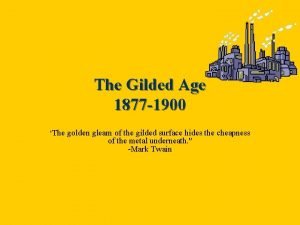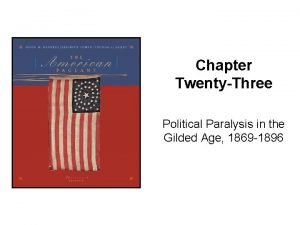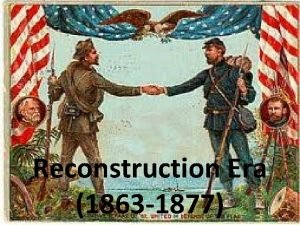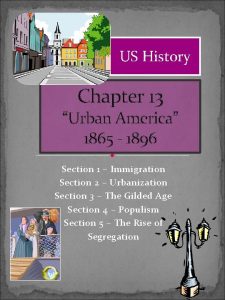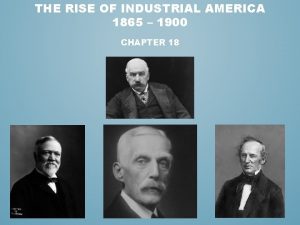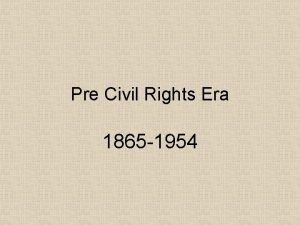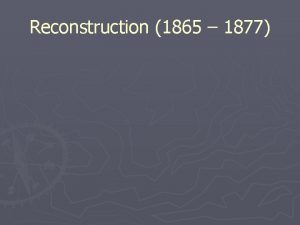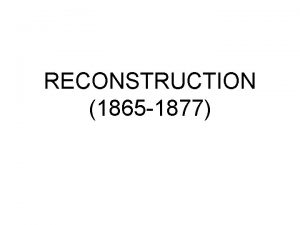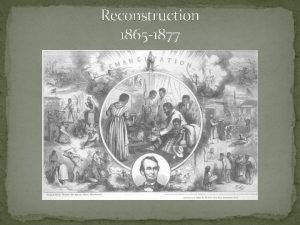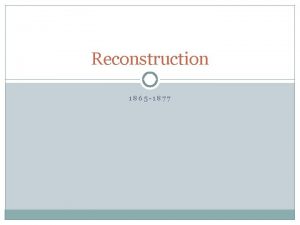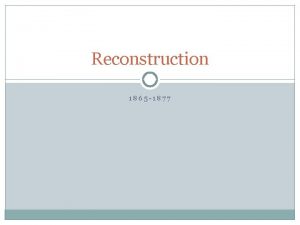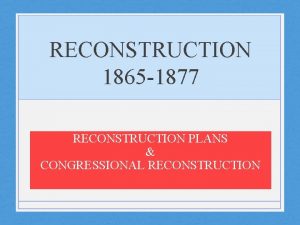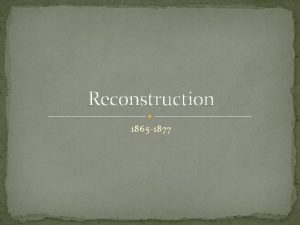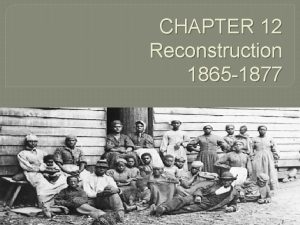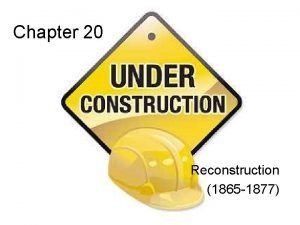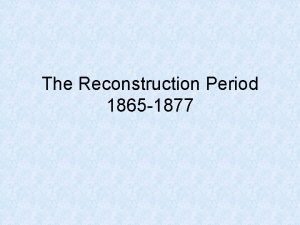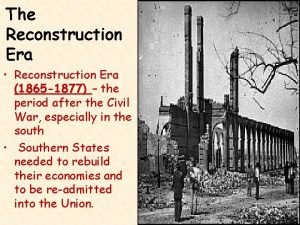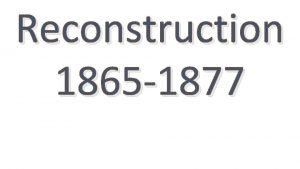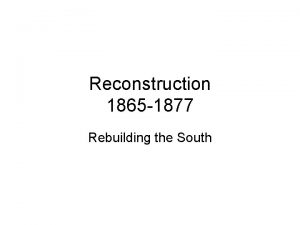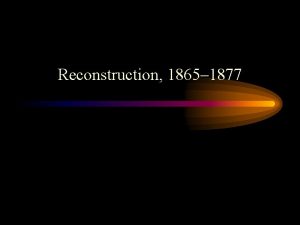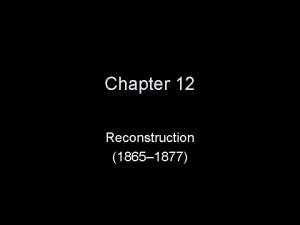Reconstruction 1865 1877 A Issues of Reconstruction 1






















- Slides: 22

Reconstruction 1865 -1877

A. Issues of Reconstruction • 1. Main Issue - Because the Constitution did not deal with the issue of secessionism, it did not address the issue of how a state may "reenter" the Union or who was responsible for reconstructing the South. • 2. Readmission of the Southern States to the Union • 3. Treatment of Ex-Confederates, those who had taken up arms against the US • 4. Civil Rights of Black citizens, most of whom were former slaves. 5. Make-up of the New State Governments

B. Goals of Reconstruction 1. Northern politicians hoped to reconstruct Southern Society, so that rights former slaves were insured, and a political base for the Republican Party could be formed. 2. Lincoln hoped to produce a speedy recovery for the South a. If the South were part of the Union, a crippled South would cripple the nation. b. A political realist, he also hoped to attract former Whigs, pro-Unionists and newly enfranchised Blacks into Republican ranks. 3. Presidential Reconstruction -- Ten Percent Plan a. Abraham Lincoln did not recognize a states' right to leave the Union and proceeded to determine the policies of reconstruction based on these liberal secessionist views. b. By Jan 1864, Tennessee, Louisiana and Arkansas offered loyal state governments on the basis of Lincoln's Reconstruction Plan.

B. Goals of Reconstruction cont. 4. Congressional Reconstruction - Congress assumed that reconstruction was a legislative prerogative, not of the executive branch, because statehood was under their jurisdiction a. Congressional beliefs (1) Many Congressmen believed that the South should be more severely punished for bringing the war to the nation and should be made to pay war costs. (2) While agreeing with Lincoln that mass executions for treason were not in order, they did not want key Confederate political or military leaders to emerge as leaders of postwar South.

4. Congressional Reconstruction Cont. b. Wade-Davis Bill (1) Congress, led by Sen. Benjamin Wade of Ohio and Rep. Henry Davis , passed a much harsher plan of reconstruction (Wade-Davis Bill). (2) The plan required a total of fifty percent of the number of voters in 1860 before a new government could be formed, while exempting most Ex-Confederates from participation. (3) State constitutions had to repudiate Confederate debts and prohibit slavery. c. Although the bill passed Congress, it was within two weeks of adjournment and was therefore pocket vetoed by Lincoln.

B. Goals of Reconstruction Cont. 5. Brutal Mistake for the South a. Lincoln's plan would have produced a speedy recovery for the South, and would have provided Federal funding for rebuilding the South, but unfortunately, Lincoln was assassinated on 14 Apr 1865 at Ford's Theater, by John Wilkes Booth b. Booth was himself allegedly shot in a barn on 26 Apr near Bowling Green VA

C. Struggle Between the Legislative and Executive Branches over Reconstruction 1. Presidential Reconstruction Under Andrew Johnson a. As a Southern Democrat, he was known to despise Southern aristocratic plantation owners and favored the 13 th amendment, proposed by Congress in Feb 1865. b. Lincoln's death temporarily shifted momentum to Congress, many of whom waited to see what the new President would do, hoping he would favor a harsher plan, similar to the Wade-Davis Bill

(Reconstruction under Johnson cont. ) c. Johnson's Plan (1) Because Congress was adjourned when Lincoln was killed, Johnson offered reconstruction to Southern states which soon revealed that he favored a plan much like Lincoln's 10% Plan. (2) When Congress reconvened in December, all Southern states had accepted the President's requirements except Mississippi sending all-white delegations to congress for roll call, including representative Alexander Stephens (GA), former Confederate vice-president. (3) Johnson also granted amnesty to thousands of exrebels, barring only those with sizable property holdings from taking oaths of allegiance (although many wealthy CSA supporters were pardoned after directly petitioning Johnson)

d. Johnson Governments (1) Many new Southern governments placed restrictions on former slaves (a) Denying blacks (males) the right to vote. (b) Not allowing for the education of former slaves. (c) Taking steps to keep blacks from acquiring real property. (d) Black Codes (1865 -66) in many cases resembled the former slave codes with the name "freedman" written in where the word "slave" had been. i) The codes did recognize black marriages. ii) They also permitted blacks to sue and to testify in court in some cases. iii) In some cases blacks could obtain certain types of property. (2) These "Reconstructed Governments" left former slaves in little better condition than as slaves, reducing them to a subordinate role and into sharecropping as a way of life for most.

2. Congressional Response -- Radical Reconstruction a. Congressional Makeup (1) Radical Republicans - wanted Southern states treated more like conquered provinces, to insure that Blacks had certain civil rights, especially the vote. (2) Senator Charles Sumner (1811 -74) MA (Senator from 1851 until his death) - desired immediate racial equality and punishment for the South. (3) Demoralized Democratic minority - size greatly reduced by the South's defection (4) Small conservative Republican faction - desired a quick return to normalcy (5) Large moderate Republican faction - provided the crucial swing vote.

Congressional Response cont. (b) Civil Rights Act Apr 1866 i) It granted full citizenship to all persons born on US soil (except Indians, not taxed) with full rights of the civil laws to which any citizen were entitled. ii) It gave black citizens the same rights as whites, and prohibited the states from restricting the rights of Blacks to testify in court or to hold court. iii) Johnson's veto along constitutional lines claimed that it diminished a states' right to make its own laws and weakened the limits on Federal power. iv) But a further explanation that it would provide "security for the colored race, safe-guards which go infinitely beyond any that the General Government has ever provided for the white race, " again lost him crucial moderate support in Congress, which again overrode his veto (the first major piece of vetoed legislation overridden by Congress).

Congressional Response cont. (2) Midterm Elections – 1866 a. Radical Republicans win 2/3 of congressional seats, every contested governor’s seat and control of all northern legislatures b. Congress was now veto-proof and radical reconstruction goes into full swing

3. Radical Reconstruction a. 1 st Reconstruction Act of 1866 (1) Confederacy divided into 5 military districts, each governed by a major general appointed by the president (2) Each state was to call new constitutional conventions elected by all adult males, excluding ex-confederates (3) Military empowered to register voters when Southerners refused to call such conventions (4) State constitutions had to guarantee the right to vote to Blacks and legislatures had to recognize the 14 th Amendment

b. Other Congressional Acts (1) Command of the Army Act (March 1867) -- Prevented the President from interfering with major generals by requiring all presidential orders go through the General of the Army (Grant) (2) Tenure of Office Act (March 1867) -- Prevented the President from removing anyone from office who had been approved by congress w/o congressional approval -- Johnson tests the constitutionality by firing Sec. Of War, Stanton twice. -- Congress responds by impeaching Johnson

C. Johnson’s Impeachment (Feb. 1868) (1) By a simple majority, the House voted to impeach Johnson for high crimes (a) He was charged with 11 counts (9 relating to the Tenure of Office Act; 2 related to his behavior toward Congress). (b) He never appeared at the trial, but was represented by former AG Henry Stanberry (2) The Senate vote 35 -19 (7 Republicans/ 12 Democrats) failed by 1 vote to convict and remove Johnson. (a) The deciding vote was cast by Republican Senator Edmund G. Ross (KS), which ruined his political career. (3) Stanton resigned as soon as the trial ended and Congress adjourned. (4) Johnson finished his term ineffectively after which he returned to the US Senate (1875), although he died after 5 months into its term.

C. Reconstruction Wrap-up 1. Compromise of 1877 1. Disputed election bring Hayes to power 2. Compromise reached, in part to gain southern support for election results 3. In return for southern support and southern guarantees of Black civil rights, Hayes agreed to four things: 1. 2. 3. 4. No second term Remove remaining federal troops from SC, LA, & FL Make a fair # of appointments to federal positions from among Southerners, including at least one cabinet position Spend fairly federal funds for internal improvements in the South

C. Reconstruction Wrap-up 2. Constitutional Amendments a. 13 th – Abolished Slavery b. 14 th – Guaranteed rights of citizenship to all natural born Americans c. 15 th – Guaranteed suffrage to Black men 3. Corruption a. Corruption in Southern gov’t. existed but no more than other similar governments and Northern municipal gov’t. b. Southern governments were never controlled entirely by Blacks (No Black governors, SC lower house only one to have a majority of Blacks)

C. Reconstruction Wrap-up 4. Positive Accomplishments a. b. c. d. e. more equitable tax system. an expansion of State Railroad systems promoted physical reconstruction increased public services created a lasting public school system. 5. Support a. Scalawags b. Carpetbaggers

C. Reconstruction Wrap-up 6. Resistance a. Drawing the Color Line (race rather than economics) a. Poor whites aligned themselves with other whites rather than with poor blacks against the wealthier whites who controlled Southern politics and economics. b. Democratic dominance emerged again in the New South

C. Reconstruction Wrap-up 6. Resistance cont. b. Ku Klux Klan • • • Several secret white organizations (Knights of the White Camellia, Society of the White Rose) arose in the post-war era to aid the return to a pre-war relationship between the races. Founded in Pulaski TN in 1865 -66 as a social club by 6 exconfederate soldiers, including Gen Nathan Bedford Forrest , the Ku Klux Klan (Greek kuklos - "circle") spread quickly throughout the South. Although Forrest was "Grand Wizard of the Empire" in 1867, Klan goals increasingly deteriorated to keeping Blacks out of politics, using violence against scalawags and blacks.

C. Reconstruction Wrap-up b. KKK cont. 1. To curb violence, Forrest ordered the Klan to disband (1869), but at a Grand meeting in Nashville, the Invisible Empire of the South was born with secret rituals and many levels - Grand Wizard, Grand Dragon, Grand Fury, Grand Titan, Grand Hydra, Grand Nighthawk 2. Repeated violence increasingly offended Northern public opinion and many respectable KKK members withdrew from the organization but local Klavens would not disband nor discontinue its violence.

C. Reconstruction Wrap-up • The rise of the KKK, which peaked in 186872, paralleled the return of conservative control of the Southern legislatures with the withdrawal of federal troops. • By the end of Reconstruction, all Southern governments had been returned to Southerners who overturned much that had been done for Blacks in the South.
 1877-1865
1877-1865 Whats the compromise of 1877
Whats the compromise of 1877 The gilded age 1877 to 1898 worksheet answers
The gilded age 1877 to 1898 worksheet answers Period 5 key concepts apush
Period 5 key concepts apush 1877 golden 1
1877 golden 1 Great railroad strike of 1877 significance
Great railroad strike of 1877 significance Compromise of 1877
Compromise of 1877 Tanssija 1877-1927
Tanssija 1877-1927 Bourbon triumvirate definition
Bourbon triumvirate definition The key tradeoff featured in the compromise of 1877
The key tradeoff featured in the compromise of 1877 Gilded age strikes
Gilded age strikes Reconstruction art definition
Reconstruction art definition Compromise of 1877 apush
Compromise of 1877 apush Gregor mendel 1865
Gregor mendel 1865 Urban america 1865 to 1896
Urban america 1865 to 1896 Four features of industrial manufacturing (1865-1900)
Four features of industrial manufacturing (1865-1900) 1865 to 1900 inventions
1865 to 1900 inventions Traits of impressionism
Traits of impressionism Impressionism characteristics
Impressionism characteristics St helen’s smelting co v tipping (1865)
St helen’s smelting co v tipping (1865) 1954-1865
1954-1865 Chapter 20 becoming a world power notes
Chapter 20 becoming a world power notes Regionalism in literature
Regionalism in literature
